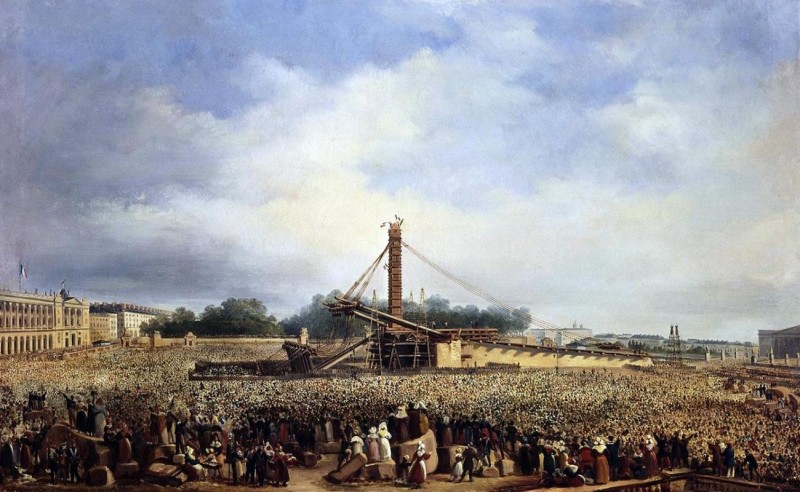
Mai 1830 – Afin de s’attirer les faveurs de la France, le Vice Roi d’Egypte Mohamed Ali, offrit à Charles X, les deux Obélisques du temple de Louxor, datant du 13e siècle avant JC. Un seul fera le voyage…
Les opérations commencèrent un an plus tard, en mai 1831. Rapporter ce monolithe de 23 mètres et 230 tonnes ne fut pas une mince affaire. Un bateau de 43 mètres de long et 9 mètres de haut, “Le Louxor”, censé supporter le poids du bloc, fut construit à cet effet.
Il fallut d’abord mettre en place un chemin de halage de 400 mètres entre le Temple et le Nil. Trente maisons furent rasées.
La mise à l’horizontale de l’Obélisque nécessita la force de 64 hommes et de 3 cabestans. Un mois et demi furent nécessaires pour franchir les 400 mètres qui séparaient le monument du bateau. Ce dernier dû être réajusté au dernier moment pour lui permettre d’accueillir sa charge. Après une traversée compliquée, “le Louxor” fut bloqué à Rosette par la décrue du Nil, mais finit par atteindre Alexandrie le 2 janvier 1833.
L’hiver passa. La bateau repartit en Avril pour atteindre Toulon le 10 mai, puis Paris le 23 décembre, après une escale au Havre. La convoi avait été remorqué le long des côtes atlantiques par le “Sphinx” un bateau à vapeur, puis halé le longe de la Seine par 16 chevaux, parcourant ainsi 12000 km en deux ans et demi.
Il fallut attendre encore 3 ans pour que l’Obélisque prenne la place que nous lui connaissons. La base originale, agrémentée de babouins en rut, fut jugée indécente et remplacée. On peut encore la voir au Louvre.
L’inauguration eut lieu le 25 octobre 1836 par Louis Philippe 1er, dernier roi des Français. Il fut érigé en lieu et place de la statue de Louis XV remplacée par la guillotine sous la Révolution.
La France avait offert une horloge en échange, qui orne encore aujourd’hui la Citadelle du Caire, mais qui ne fonctionna jamais…
En 1981, François Mitterrand renonça officiellement au droit de la France sur le second Obélisque resté sur place.
May 1830: To curry favour with France, the viceroy of Egypt, Mohammed Ali, presented Charles X with two obelisks from the temple of Luxor, dating from 1200-1300 B.C. Only one of them, however, would make the journey to Paris…
Work started on the project a year later, in the May 1831. Moving this enormous monolith, 23 metres long and weighing 230 tons, was going to be no small feat. The Luxor, a ship measuring 43 metres long and 9 metres high, was specifically commissioned to take the weight of the stone. First, however, a 400-metre long towpath would have to be installed to transport the obelisk from the temple to the river, which in itself involved the demolition of thirty houses. Even getting to obelisk into a horizontal position required the force of 64 men and three winches. It would take six weeks for the monument to travel these four hundred metres alone. Once it arrived, the boat had to be readjusted at the last minute to accommodate its weight.
After a difficult passage, the Luxor found itself stranded in Rosetta owing to low water levels on the Nile, but eventually reached Alexandra on the 2nd of January 1833. Once winter had passed, the boat set sail again in April, aiming to reach Toulon by the 10th of May and Paris on the 23rd of December, including a brief stop at Le Havre. The convoy had been towed throughout its Atlantic voyage by the Sphinx, a steamboat, and then hauled up the length of the Seine by 16 horses, travelling 12,000 km in total over its two-an-a-half-year journey.
Three more years would pass before the obelisk would be placed in its current position. The original plinth, decorated with rutting baboons, was considered indecent and had to be replaced (it is still visible at the Louvre).
The monument was officially inaugurated on the 25th of October 1836 by Louis Phillipe I, the last king of France. It was erected on the former site of the statue of Louis XV, which had been replaced with the Guillotine during the revolution. In exchange for this gift, the French offered the Egyptians a clock, which still adorns the Citadel of Cairo, but which never actually functioned …
In 1981, François Mitterrand officially renounced France’s right to the second obelisk, which has remained in its original position at Luxor.
LOCALISER / LOCATE






Une réponse
Lynda Ouar
Merciii pour l’histoire et l’iconographie !!
J’avais écouté ce long périple dans une émission de France Culture. Je vous la conseille vivement.
Bravo pour vos articles et votre blog que je suis régulièrement.
http://www.franceculture.fr/emission-un-autre-jour-est-possible-une-histoire-de-l-egypte-dvd-%C2%AB-dernier-etage-gauche-gauche-%C2%BB-201